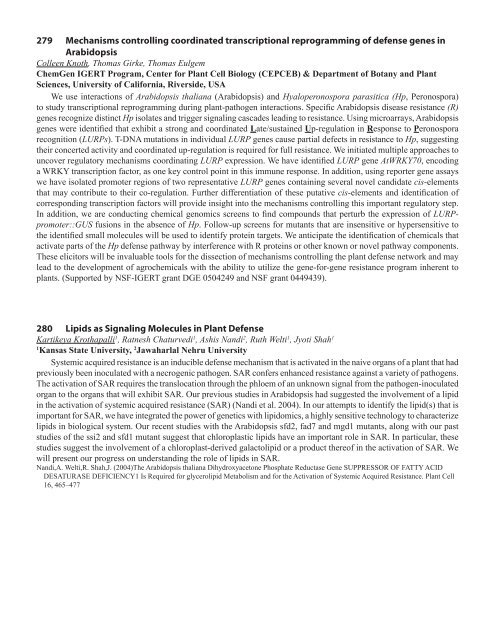75 Integrating Membrane Transport with Male Gametophyte ... - TAIR
75 Integrating Membrane Transport with Male Gametophyte ... - TAIR
75 Integrating Membrane Transport with Male Gametophyte ... - TAIR
You also want an ePaper? Increase the reach of your titles
YUMPU automatically turns print PDFs into web optimized ePapers that Google loves.
279 Mechanisms controlling coordinated transcriptional reprogramming of defense genes in<br />
Arabidopsis<br />
Colleen Knoth, Thomas Girke, Thomas Eulgem<br />
ChemGen IGERT Program, Center for Plant Cell Biology (CEPCEB) & Department of Botany and Plant<br />
Sciences, University of California, Riverside, USA<br />
We use interactions of Arabidopsis thaliana (Arabidopsis) and Hyaloperonospora parasitica (Hp, Peronospora)<br />
to study transcriptional reprogramming during plant-pathogen interactions. Specific Arabidopsis disease resistance (R)<br />
genes recognize distinct Hp isolates and trigger signaling cascades leading to resistance. Using microarrays, Arabidopsis<br />
genes were identified that exhibit a strong and coordinated Late/sustained Up-regulation in Response to Peronospora<br />
recognition (LURPs). T-DNA mutations in individual LURP genes cause partial defects in resistance to Hp, suggesting<br />
their concerted activity and coordinated up-regulation is required for full resistance. We initiated multiple approaches to<br />
uncover regulatory mechanisms coordinating LURP expression. We have identified LURP gene AtWRKY70, encoding<br />
a WRKY transcription factor, as one key control point in this immune response. In addition, using reporter gene assays<br />
we have isolated promoter regions of two representative LURP genes containing several novel candidate cis-elements<br />
that may contribute to their co-regulation. Further differentiation of these putative cis-elements and identification of<br />
corresponding transcription factors will provide insight into the mechanisms controlling this important regulatory step.<br />
In addition, we are conducting chemical genomics screens to find compounds that perturb the expression of LURPpromoter::GUS<br />
fusions in the absence of Hp. Follow-up screens for mutants that are insensitive or hypersensitive to<br />
the identified small molecules will be used to identify protein targets. We anticipate the identification of chemicals that<br />
activate parts of the Hp defense pathway by interference <strong>with</strong> R proteins or other known or novel pathway components.<br />
These elicitors will be invaluable tools for the dissection of mechanisms controlling the plant defense network and may<br />
lead to the development of agrochemicals <strong>with</strong> the ability to utilize the gene-for-gene resistance program inherent to<br />
plants. (Supported by NSF-IGERT grant DGE 0504249 and NSF grant 0449439).<br />
280 Lipids as Signaling Molecules in Plant Defense<br />
Kartikeya Krothapalli 1 , Ratnesh Chaturvedi 1 , Ashis Nandi 2 , Ruth Welti 1 , Jyoti Shah 1<br />
1<br />
Kansas State University, 2 Jawaharlal Nehru University<br />
Systemic acquired resistance is an inducible defense mechanism that is activated in the naive organs of a plant that had<br />
previously been inoculated <strong>with</strong> a necrogenic pathogen. SAR confers enhanced resistance against a variety of pathogens.<br />
The activation of SAR requires the translocation through the phloem of an unknown signal from the pathogen-inoculated<br />
organ to the organs that will exhibit SAR. Our previous studies in Arabidopsis had suggested the involvement of a lipid<br />
in the activation of systemic acquired resistance (SAR) (Nandi et al. 2004). In our attempts to identify the lipid(s) that is<br />
important for SAR, we have integrated the power of genetics <strong>with</strong> lipidomics, a highly sensitive technology to characterize<br />
lipids in biological system. Our recent studies <strong>with</strong> the Arabidopsis sfd2, fad7 and mgd1 mutants, along <strong>with</strong> our past<br />
studies of the ssi2 and sfd1 mutant suggest that chloroplastic lipids have an important role in SAR. In particular, these<br />
studies suggest the involvement of a chloroplast-derived galactolipid or a product thereof in the activation of SAR. We<br />
will present our progress on understanding the role of lipids in SAR.<br />
Nandi,A. Welti,R. Shah,J. (2004)The Arabidopsis thaliana Dihydroxyacetone Phosphate Reductase Gene SUPPRESSOR OF FATTY ACID<br />
DESATURASE DEFICIENCY1 Is Required for glycerolipid Metabolism and for the Activation of Systemic Acquired Resistance. Plant Cell<br />
16, 465–477





